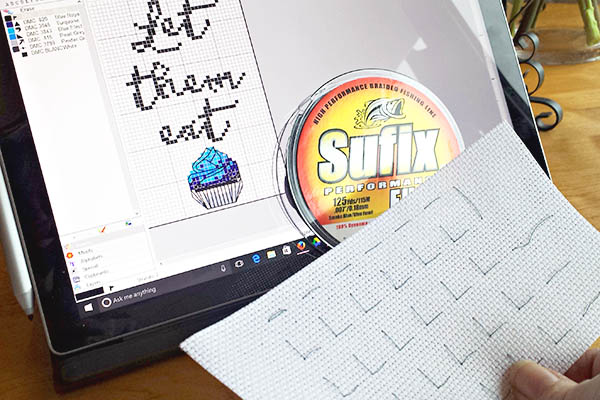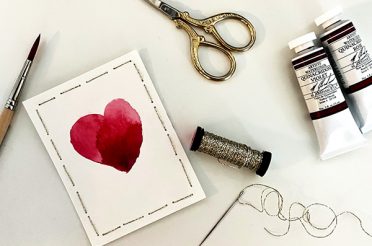If you’ve ever seen a picture of what looks like thread running in a grid on a cross stitch project, it’s likely that the stitcher did their gridding with fishing line or something similar. Using fishing line is great as it won’t leave permanent marks on your fabric, it’s inexpensive, and it’s reusable! This video tutorial will show you how to grid your fabric with fishing line, and the featured pattern in it is also a free cross stitch pattern available to Peacock Lounge members.
Disclosure: Please note that some of the links in this post are affiliate links and if you go through them to make a purchase I will earn a commission. Keep in mind that I link these companies and their products because of their quality, and not because of the commission I receive from your purchases. I would never recommend something I wouldn’t use myself. 🙂
To use this gridding method, one type of thread you can use is Easy Count Guideline. It’s is designed specifically for needlework, and it’s a fine red nylon thread (that you can reuse). Not all needlework shops carry it, but many do. If you’re having a hard time finding it or it’s too expensive in the store you found it in, you can use fishing line instead. In the video below I’m using 8 pound test dark blue fishing line (it’s strong enough to catch a fish 8lbs or less, but basically it’s a fine gauge fishing line).
Gridding is great because you can “mimic” the darker gridlines in your pattern (usually every tenth row or column) onto your fabric. By having the same grid on your fabric as on your pattern, you can lessen the chance of making mistakes. You can also actually end up stitching faster (as you can find where your next stitch needs to go more easily). Both gridding using fishing line and by drawing the lines on (as in this gridding video) take time, but this method saves time later from unpicking mistakes. Fishing line or Easy Count Guideline is preferable to sewing thread as it can’t be punctured by your needle, and your floss slips easily around it. You can also just pull out the line when you’re finished, meaning it’s reusable for next time. Some stitchers also love using Sulky® Sliver metallic thread to grid their fabric with as well, so there are lots of options. Fabric markers can leave permanent marks on fabric if left on for too long, so if you have a large project it’s preferable to stitch your grid lines than it is to draw grid lines. Fabric markers can also leave lines on your fabric that show up again (after washing them out) if the fabric gets too cold — I’ve heard of stitchers mailing their pieces for exhibitions or competitions only to have the grid lines return because the stitching got cold in the mail system. Stitching your grid lines is also perfect for linen and evenweave fabric, which can be harder to draw lines on as they are very fine fabrics.
To stitch your fishing line into your fabric, use a fine sewing needle to thread your fishing line onto. Don’t use a tapestry needle, or the needle might make the holes in your fabric slightly wider — you could end up with a little grid of holes all over your fabric when you remove the line. It’s not a big deal if that happens as usually washing and ironing your finished cross stitch piece will take care of that, but it’s easier to prevent it in the first place.
In the video you’ll see I come up in the first hole, count over 1-4 holes, and then go back under on the fifth. Then I count 6-9, and come up on the tenth hole. In this manner I’m going over five, under five, over five, etc. You can go over ten and under ten, or over 2 and under eight, whatever you like. Just make sure to be careful when counting during gridding, as you don’t want to throw the rest of your grid off by accident.
Enjoy the video below, and if you’d like the free cross stitch pattern “Let Them Eat Cupcakes” featured in this video, please click here to join the Peacock Lounge and get your free pattern! 🙂
Gridding with fishing line
Links mentioned in the video:
Gridding using pencil or fabric pen
How to centre your pattern on the fabric










22 Responses
Nathan
I’m curious about how you start and end each grid strand. Like do you knot them or just have them hang loose? If they’re loose how do you prevent them coming out? I’ve gridded before but just with pencil but I can never seem to get the marks out completely so I want to try something different. Thanks!
Dana Batho
Hi Nathan! You just leave them loose (and long enough you can grab the ends later to pull the threads out). They won’t come out, unless you’re tossing your project around like a toy there’s no reason the strands should come out. 🙂
Laura
About 3-4 years ago I discovered the nylon thread for gridding. Being just over half way through a tedious project, I started gridding where I was. It made the rest of the project so much easier. I’ve been gridding ever since. And you can start stitching in any area you please. I taught myself from the included instructions. Your tutorial would have made it so much easier to learn!
Dana Batho
Haha that’s ok Laura, sometimes you just learn things as you go which isn’t a bad thing. Glad you enjoyed the tutorial though! 🙂
Keryn
Hi,
Is it fine to grid with fishing line when using q snaps that are smaller than the finished piece, or a scroll frame?
Thanks
Dana Batho
Hi Keryn! Absolutely, no matter which style of hoop or frame you use, the fishing line shouldn’t end up getting moved at all. 🙂
Sharon
Do you just put the cross stitch over the grids or do you take it our as you go thanks
Dana Batho
Hi Sharon! You just stitch over the grids. You can take it out as you go, but that’s more of a pain than it’s worth, that’s why you use really fine fishing line or nylon thread. It doesn’t get in the way of the stitches. 🙂
Amanda
I read through your website and it is very helpful! Thank you for this. I am new to cross stitching and I am wondering if gridding with fishing line will be difficult when using a hoop. Thanks again, I have favourited your website!
Dana Batho
Hi Amanda! A hoop shouldn’t affect your gridding at all, just be careful when you’re moving the hoop to not pull on the gridding too much. You should still be able to stitch no problems. Happy stitching! 🙂
Ray
I’ve yet to try gridding, but I think I am going to try it on the next piece I start after I finish the two I have now. I stitch in columns of 10 rows all the way down the piece. Makes for an interesting back. I was wondering if you had a preference to gridding line brands?
Dana Batho
Haha yeah as long as you’re using line that’s fine enough for your gridding, then any brand is fine. The specialty stuff you get in needlework shops is more expensive than just using fishing line, or many stitchers use Sulky Sliver thread (as it can’t be pierced). Just be aware that if you stitch in perfect rows, you’ll get “banding” where your tension changes from each column to the next column. It usually comes out when you wash and iron your piece, but a trick to prevent that is to make your columns more jagged (like a jigsaw puzzle, alternate the number of rows you’re stitching per line). Like stitch ten stitches one row, 8 the next, 12 the next, etc. Then there are no straight lines between the columns, and no banding. 🙂
Sharon
Hi. I have been watching your videos and they are awesome. I am still relatively new to cross stitch. I’ve done MAYBE 5 complete pieces so far, the largest being an 8×10 photo quality for a friend. I have another that I’m about to start which the material piece was 25×40 14ct folded when sold and the project size is 15.6×36.8 in. Most of my project have been without a hoop, but I haven’t worked with so much material. I was wondering if you had any suggestions dealing with fraying that I have noticed happen when I free stitch. I have tried masking tape and it made one sticky, and I haven’t had much luck with the fray check either. Considering the size of material, would it be better to iron out the folds before starting? Luckily my project won’t be a solid piece but a lot of separate ones that will measure 205×516 stitches. Thank you!
Dana Batho
Hi Sharon! I’d try and iron out some of the main creases before you stitch if you can. But if you finish and you have a hard time getting the remaining creases out, one neat tip I just heard was to soak your piece (I always wash my pieces anyway), roll up the piece in a towel and get out the excess moisture, and then roll it up without the towel and stick it in the freezer. When it’s frozen, pull it out, unroll it, and iron it while it’s still frozen. Apparently that’s a foolproof way to get stubborn creases out. 🙂 As for the fraying, I never seal my edges (I find it only frays a few strands then stops), but you could also try painter’s tape. It won’t leave a residue, and should stop your fraying. You can also use a serger or stitch a zigzag stitch along the edge with a sewing machine. Hope that helps! 🙂
Carlene
Thanks for the video. Any tips on a putting a grid on linen?
Dana Batho
Hi Carlene, thanks very much for your comment! Sorry it took so long for me to respond, I didn’t get the notification you’d posted! You can do exactly the same thing on linen — grid in the lines with fishing line. The rows of holes are much finer, so you’ll just have to be careful to count accurately. I’d recommend gridding with fishing line (or other nylon thread) to be the only way you could really successfully grid linen as it is very fine fabric. So if you’re stitching over 2 for your project on linen, just count 20×20 for each grid of “10”, as you’ll be skipping every second hole. Does that help? Let me know if you have any other questions! 🙂
Ron Lynn
Nice video Dana, thanks! I’ve been cross stitching for 20 years or more and have never gridded before. I’ve never had any problems. However, I can certainly see the appeal. I’m about to embark upon a project that will probably take me several years to complete. I’d like to grid the pages of the pattern (there are over 150 pages). I can’t imagine gridding all the 10x10s, there would be nearly 7000. It will be done on a black 25ct fabric. A couple of questions:
1) what should one use to grid on black fabric?
2) any guidance for gridding pages?
Again, thanks for the video!
Dana Batho
Hi Ron, thanks for the questions! That sounds like an amazing project you’re about to start on! For black linen I’d actually recommend clear fishing line. If you have decent lighting when you’re stitching, it will reflect the light and look almost white, so that should be easy enough to see. Try a bit out and see if it will work for you before gridding the whole piece. And if you don’t want to grid each 10×10, you could do the even # grids (like 20×20), or even grid the full pages as one “grid” on your fabric. Just be careful about any pattern overlap, that might be tricky when moving to the next page. Does that help? 🙂
Ron Lynn
Thank you. That helps a bunch. Happy Holidays!
Dana Batho
Haha you’re very welcome Ron! Happy holidays to you too! 😀
Elsie Hunter
I’ve used gridding on my last two projects and I love it! It does take time to grid, but in the end it’s worth it and soooo much easier to stitch. Anyway, thanks for sharing this technique.
Dana Batho
Haha you’re very welcome Elsie, I’m glad you enjoy the benefits of gridding! Happy stitching! 🙂